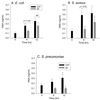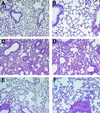Fas/Fas ligand system mediates epithelial injury, but not pulmonary host defenses, in response to inhaled bacteria
- PMID: 11500454
- PMCID: PMC98694
- DOI: 10.1128/IAI.69.9.5768-5776.2001
Fas/Fas ligand system mediates epithelial injury, but not pulmonary host defenses, in response to inhaled bacteria
Abstract
The Fas/Fas ligand (FasL) system has been implicated in alveolar epithelial cell apoptosis during pulmonary fibrosis and acute respiratory distress syndrome. However, Fas ligation can also lead to cell activation and cytokine production. The goal of this study was to determine the role of the Fas/FasL system in host defenses against Escherichia coli, Staphylococcus aureus, and Streptococcus pneumoniae. We administered bacteria by aerosolization into the lungs of Fas-deficient (lpr) mice and wild-type (C57BL/6) mice and measured bacterial clearance at 6 and 12 h. One hour prior to euthanasia, the mice received an intraperitoneal injection of human serum albumin (HSA) for alveolar permeability determinations. At all times after bacterial challenges, the lungs of the lpr mice contained similar or lower numbers of bacteria than those of the C57BL/6 mice. Alveolar permeability changes, as determined by bronchoalveolar lavage fluid HSA concentrations, were less severe in the lpr mice 6 h after the challenges. In response to E. coli, the lpr mice had significantly more polymorphonuclear leukocytes (PMN) and macrophage inflammatory protein 2 in the lungs, whereas histopathologic changes were less severe. In contrast, in response to the gram-positive cocci, the lpr animals had similar or lower numbers of PMN. We conclude that the Fas/FasL system contributes to the development of permeability changes and tissue injury during-gram negative bacterial pneumonia. The Fas/FasL system did not have a major role in the clearance of aerosolized bacteria from the lungs at the bacterial doses tested.
Figures





References
-
- Aaberge I S, Eng J, Lermark G, Lovik M. Virulence of Streptococcus pneumoniae in mice: a standardized method for preparation and frozen storage of the experimental bacterial inoculum. Microb Pathog. 1995;18:141–152. - PubMed
-
- Boussaud V, Soler P, Moreau J, Goodwin R G, Hance A J. Expression of three members of the TNF-R family of receptors (4-1BB, lymphotoxin-beta receptor, and Fas) in human lung. Eur Respir J. 1998;12:926–931. - PubMed
-
- Fine A, Anderson N L, Rothstein T L, Williams M C, Gochuico B R. Fas expression in pulmonary alveolar type II cells. Am J Physiol. 1997;273:L64–L71. - PubMed
-
- Frevert C W, Matute-Bello G, Skerrett S J, Goodman R B, Kajikawa O, Sittipunt C, Martin T R. Effect of CD14 blockade in rabbits with Escherichia coli pneumonia and sepsis. J Immunol. 2000;164:5439–5445. - PubMed
-
- Gochuico B R, Williams M C, Fine A. Simultaneous in situ hybridization and TUNEL to identify cells undergoing apoptosis. Histochem J. 1997;29:413–418. - PubMed
Publication types
MeSH terms
Substances
Grants and funding
LinkOut - more resources
Full Text Sources
Molecular Biology Databases
Research Materials
Miscellaneous

